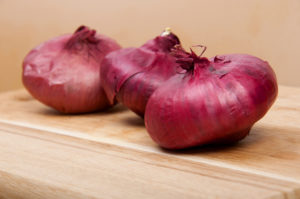While many of you already know that chocolate can make your cat or dog sick, did you know that onions can kill? I learned this my second year in veterinary school. But I didn’t really appreciate it until the big onion incident that occurred during my senior year. Well, maybe the incident wasn’t all that big; it only involved one dog. But it was my own dog, Max, a 72-pound adult Boxer. And it nearly killed him.
Not surprisingly, pets actually have to eat the onions to get sick, but depending on their size, they may not have to eat much. One fourth of a cup can make a 20-pound dog sick while several cups may be needed to make a large dog sick. Cats are even more sensitive.
You’re probably asking yourself, “What dog or cat with brains would eat onions?” Well, the onions don’t have to be raw. They can be fried as in onion rings, dehydrated, as in Lipton Soup, or prepared in some other tasty form such as sautéed with mushrooms and steak, or hidden in a souffle. In a scattered rash of cat onion toxicity cases a number of years back, the culprit was onion powder used to flavor some baby foods. Veterinarians often temporarily feed meat baby food to cats who are infirmed and unwilling to eat their regular foods. So when the baby food formulations changed, some cats took a turn for the worse while under veterinary care. Due to public pressure baby foods no longer contain onion powder.
In Max’s case, the onions were fried, dried and then left on the coffee table by my roommate before she left for the weekend. I never saw the pound or so of deadly cuisine. All I found was an empty bag and drool on the floor. If I had known what was in the bag, I would have taken Max to my veterinarian immediately. Instead I took him two days later, after the normally boisterous prankster collapsed while exercising. We performed a bunch of diagnostic tests, and on examining the blood work, found the tell-tale signs—little purple clumps in his red blood cells that virtually screamed onion toxicity.
Onions cause toxicity by oxidizing an oxygen-transporting protein called hemoglobin in the red blood cells. When oxidized, hemoglobin forms clumps which can’t carry oxygen as well. These small clumps, called Heinz bodies can be seen in the red blood cells when the blood is viewed under a microscope, especially when the cells are stained with a special stain called New Methylene Blue. Although a number of other compounds can cause Heinz bodies, when a veterinarian sees Heinz bodies in many cat or dog red blood cells, onion toxicity is the first differential that leaps out on the list. Normally, in dogs with onion toxicity a moderate number of red blood cells may contain Heinz bodies. In Max’s case, most of the red blood cells carried the protein clumps.
Heinz bodies don’t usually cause life-threatening problems themselves; the red blood cells can still carry oxygen, just not as efficiently. Heinz bodies cause problems by decreasing the red blood cell lifespan. As a result, the onion-eater becomes anemic. If a large amount of onions is eaten at one time, the pet may develop a sudden anemia several days following the onion feast. If the dog or cat eats a small amount of onions every day for many days, he may gradually develop anemia over weeks to months.
Onion toxicosis is not a tremendously common occurrence. Annually, the ASPCA National Animal Poison Control Center in Urbana Illinois records only a handful to a dozen calls on onion toxicity and toxicity from its relatives in the Allium genus, garlic and chives. Probably because with low dose exposure, pets may not develop signs severe enough to take to a veterinarian or at least not sick enough to perform diagnostic bloodwork for a definitive diagnosis.
It’s a good thing the incidence is relatively low, since patients that do eat enough onions to develop toxicosis often need to be hospitalized for several days. In cases of severe anemia, they may even need a life-saving blood transfusion. Max did. Luckily most victims of onion over-ingestion respond well to treatment and recover.
Interestingly, garlic can cause the same problems as onions, but since garlic is usually only used in small amounts, dogs and cats aren’t likely to ingest a toxic quantity.
The signs you see with onion toxicosis are signs of anemia and low oxygen such as lethargy, weakness, red urine, decreased stamina, and pale or bluish gums, especially with exercise. While onion toxicity is not a common cause of these signs, consider onion toxicosis if you see these signs and know your pet has gotten into onions recently. If by some freak occurrence, your dog or cat does engage in an onion feast, take him to your veterinarian immediately. She may induce vomiting or administer a product to help decrease the absorption of the onions. If you take this trip in time, your onion eater may be spared many or all of the hazardous sequelae of onion toxicosis and you may be spared the much larger bill associated with intense hospital monitoring and a several night stay.
Footnote: Other human foods to avoid include moldy walnuts, grapes or raisins, chocolate, fatty foods.
For more information on the ASPCA National Animal Poison Control Center, go to http://www.aspca.org/pet-care/poison-control/.
To consult with a veterinarian at the Center’s emergency hotline for a $65.00 fee call (888) 426-4435.



